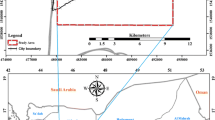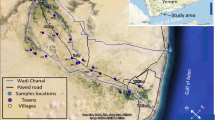Abstract
The present investigation deals with gamma radiation survey and analysis of uranium in groundwater samples collected from the Kanniyakumari district. It reveals that gamma dose rate varies from 58 to 3880 nSv/h (mean 276 nSv/h) and uranium concentration varies from ≤ 0.2 to 10 µg/L (median 0.4 µg/L) in the pre-monsoon and ≤ 0.2 to 14.9 µg/L (median 0.2 µg/L) in the post-monsoon seasons. The present study shows that Manavalakurichi and Indranagar junctions have high background radiation due to the monazite placer deposits. The alkaline and reductive nature of groundwater minimizes the leaching of uranium from these monazite placer deposits.






Similar content being viewed by others
References
Erikson R, Hostetler C, Divine J, Price K (1990) A review of the environmental behavior of uranium derived from depleted uranium alloy penetrators. PNL-7213, Pacific Northwest Laboratory, 1990a, Richland, WA
Arabi SA, Funtua II, Dewu BBM, Alagbe SA, Kwaya MY, Garba ML, Baloga AD (2013) Activity concentration of uranium in groundwater from uranium mineralized areas and its neighborhood. J Radioanal Nucl Chem 295:135–142
Sarojini V (2014) Baseline Assessment of dose due to natural radionuclides in soils of coastal regions of Kanyakumari district in Tamil Nadu, India. IOSR J Environ Sci Toxicol Food Technol 8(9):01–04
Padua JC, Basil Rose MR (2013) Natural gamma radioactivity in the villages of Kanyakumari District, Tamil Nadu, India. Radiat Prot Dosim 156(1):42–48
Ajithra AK, Venkatraman B, Jose MT, Chandrasekar S, Shanthi G (2017) Assessment of natural radioactivity and associated radiation indices in soil samples from the high background radiation area, Kanyakumari district, Tamil Nadu. India Radiat Prot Environ 40:27–33
Ajithra AK, Shanthi G (2016) Assessment of natural radioactivity and radiation hazards in beach sand samples from Kanyakumari District, Tamil Nadu. IRA Int J Technol Eng. https://doi.org/10.21013/jte.v3.n3.p9
Al-Azmi D, Kumara S, Mohan MP, Karunakara N (2019) Gamma dose rates in the high background radiation area of Mangalore Region. India Radiat Prot Dosim 184(3–4):290–293
US EPA (1990) Occurrence and exposure assessment for uranium in public drinking water supplies. Report prepared by Wade Miller Associates, Inc. for the Office of Drinking Water, US Environmental Protection Agency, 26 April 1990 (EPA Contract No. 68-03-3514).
Coyte RM, Jain RC, Srivastava SK, Sharma KC, Khalil A, Ma L, Vengosh A (2018) Large-scale uranium contamination of groundwater resources in India. Environ Sci Tech Let 5(6):341–347
Chahal A, Kumar S, Panghal A (2019) Study of uranium in drinking water around the Sohna Fault Line in Haryana. J Geol Soc India 94:428–436
Nolan J, Weber KA (2015) Natural uranium contamination in major U.S. aquifers linked to nitrate. Environ. Sci. Technol. Lett. 2(8):215–220
Bonotto DM, Wijesiri B, Goonetilleke A (2019) Nitrate-dependent uranium mobilisation in groundwater. Sci Total Environ 693:133655
Ma M, Wang R, Xu L, Xu M, Liu S (2020) Emerging health risks and underlying toxicological mechanisms of uranium contamination: lessons from the past two decades. Environ Int 145:106107. https://doi.org/10.1016/j.envint.2020.106107
Federal-Provincial-Territorial Committee (2017) Drinking water uranium in drinking water document for Public Consultation Health Canada, Ottawa, ON, Canada
WHO (2003) Uranium in drinking-water. Background document for preparation of WHO Guidelines for drinking-water quality. World Health Organization, Geneva (WHO/SDE/WSH/03.04/118)
AERB Safety Guidelines (2007) Radiological safety in uranium mining and milling guidelines no. AERB/FE-FCF/SG-2; 2007
Babu MNS, Somashekar RK, Kumar SA, Shivanna K, Krishnamurthy V, Eappen KP (2008) Concentration of uranium levels in ground water. Int J Environ Sci Technol 5(2):263–266
Prat O, Vercouter T, Ansoborlo E, Fichet P, Perret P, Kurttio P, Salonen L (2009) Uranium speciation in drinking water from drilled wells in southern Finland and its potential links to health effects. Environ Sci Technol 43(10):3941–3946
Timofeev A, Migdisov AA, Williams-Jones AE, Roback R, Nelson AT, Hongwu Xu (2018) Uranium transport in acidic brines under reducing conditions. Nat Commun 9(1469):1–7
Sakthykumari I, Vijayan A, Umayoru Bhagan V, Anbu M (2004) Ground water-quality of coastal Kanyakumari district, South India. Asian J Chem 16(3):1562–1572
Srinivas Y, Hudson Oliver D, Stanley Raj A (2013) Chandrasekar N (2013) Evaluation of groundwater quality in and around Nagercoil town, Tamilnadu, India: an integrated geochemical and GIS approach. Appl Water Sci 3:631–651
Venkatesh P, Murugesan S, Dhamotharan R (2010) Assessment of groundwater quality in and around Kanyakumari district, Tamil Nadu. Biosci Biotech Res Commun 3(2):185–190
Ramesh K, Nithya K, Vennila S (2014) Groundwater quality assessment of Kurunthancode Block in Kanyakumari District, India. Int J Chemtech Res 6(11):4585–4594
CGWB (2007) Central groundwater board. District Groundwater Brochure, Kanniyakumari district, Tamilnadu. http://cgwb.gov.in/District_Profile/TamilNadu/Kanyakumari.pdf
Al-Khawlany AH, Khan AR, Pathan JM (2018) Review on studies in natural background radiation. Radiat Prot Environ 41:215–222
Butt KA, Ali A, Qureshi AA (1998) Estimation of environmental gamma background radiation levels in Pakistan. Health Phys 75(1):63–66. https://doi.org/10.1097/00004032-199807000-00011
Singh B, Kant K, Garg M, Sahoo BK (2020) Quantification of radon/thoron exhalation rates of soil samples collected from district Faridabad of Southern Haryana, India. J Radioanal Nucl Chem 326:831–843. https://doi.org/10.1007/s10967-020-07365-5
Nazir S, Simnani S, Sahoo BK, Rashid I, Masood S (2020) Dose estimation of radioactivity in groundwater of Srinagar City, Northwest Himalaya, employing fluorimetric and scintillation techniques. Environ Geochem Health. https://doi.org/10.1007/s10653-020-00576-5
Raja V, Lakshmi RV, Sekar CP, Chidambaram S, Neelakantan MA (2021) Health risk assessment of heavy metals in groundwater of industrial township Virudhunagar, Tamil Nadu, India. Arch Environ Contam Toxicol 80:144–163. https://doi.org/10.1007/s00244-020-00795-y
Ganesh D, Senthil Kumar G, Najam LA, Raja V, Neelakantan MA, Ravisankar R (2020) Uranium quantification in groundwater and health risk from its ingestion in and around Tiruvannamalai, Tamil Nadu, India. Radiat Prot Dosim ncaa024:1–12
Chandramohan J, Durai G, Harikrishnan N, Ravisankar R, Chandrasekaran A, Neelakantan MA, Raja V (2018) Study of Uranium Concentration in Drinking Water in Tiruvannamalai District, Tamil Nadu, India and Assessment of Health Risk. J Radiat Nucl Appl 3:103–110
Thillai Arasu P, Hema S, Neelakantan MA (2007) Physico-chemical analysis of Tamirabarani river water in South area. Indian J Sci Technol 1:1–7
Puthiyasekar C, Poongothai S, Neelakantan MA (2009) Impact of industrial pollution on the physicochemical characteristics of sea water in thoothukudi coastal area. Rasayan J Chem 2:912–919
Sharma T, Sharma A, Kaur I, Mahajan RK, Litoria PK, Sahoo SK, Bajwa BS (2018) Uranium distribution in groundwater and assessment of age dependent radiation dose in Amritsar, Gurdaspur and Pathankot districts of Punjab, India. Chemosphere 219:607–616
Sener S, Sener E, Davraz A (2017) Evaluation of water quality using water quality index (WQI) method and GIS in Aksu River (SW-Turkey). Sci Total Environ 584–585:131–144
Bahir M, Ouhamdouch S, Ouazar D, Chehbouni A (2020) Assessment of groundwater quality from semi-arid area for drinking purpose using statistical, water quality index (WQI) and GIS technique. Carbonates Evaporites 35(27):1–24
Monica S, Visnu Prasad AK, Soniya SR, Jojo PJ (2016) Estimation of indoor and outdoor effective doses and lifetime cancer risk from gamma dose rates along the coastal regions of Kollam district, Kerala. Radiat Prot Environ 39:38–43
ICRP (1993) International Commission on Radiological Protection, vol 23. Annals of the ICRP, Pergamon Press, Oxford, p 65
AERB (2001) Criteria for regulation of health and safety of nuclear power plant personnel, the public and the environment, AERB Safety Guide No. AERB/SG/G-8
Christa EP, Jojo PJ, Vaidyan VK, Anilkumar S, Eappen KP (2011) Radiation dose in the high background radiation area in Kerala, India. Radiat Prot Dosimetry 148(4):482–486
BIS (Bureau of Indian Standards) (2012) Indian Standard drinking water-specification, 1st rev, pp 1–8
Kaliraj S, Chandrasekar N, Peter TS, Selvakumar S, Magesh NS (2015) Mapping of coastal aquifer vulnerable zone in the south west coast of Kanyakumari, South India, using GIS-based DRASTIC model. Environ Monit Assess 187(1):4073. https://doi.org/10.1007/s10661-014-4073-2
Renforth P, Henderson G (2017) Assessing ocean alkalinity for carbon sequestration. Rev Geophys 55:636–674
Amiotte Suchet P, Probst, JL, Ludwig W (2003) Worldwide distribution of continental rock lithology: implications for the atmospheric/soil CO2 uptake by continental weathering and alkalinity river transport to the oceans. Global Biogeochem Cycles 17(2)
Li P-Y, Qian H, Jian-hua Wu, Ding J (2010) Geochemical modeling of groundwater in southern plain area of Pengyang County, Ningxia, China. Water Sci Eng 3:282–291
Piper AM (1944) A graphic procedure in the geochemical interpretation of water analysis. J Trans Am Geophys Union 25(914–923):491–494
Marandi A, Shand P (2018) Groundwater chemistry and the Gibbs Diagram. Appl Geochem 99:209–212. https://doi.org/10.1016/j.apgeochem.2018.07.009
Gibbs RJ (1970) Mechanism controlling water world chemistry. Science 170:1088–1090
Raja V, Neelakantan MA (2021) Evaluation of groundwater quality with health risk assessment of fluoride and nitrate in Virudhunagar district, Tamil Nadu, India. Arab J Geosci 14:52. https://doi.org/10.1007/s12517-020-06385-5
Finch WI, Davis JF (1985) Sandstone-type uranium deposits (IAEA-TECDOC--328). International Atomic Energy Agency (IAEA)
Zhou Y, Li G, Xu L, Liu J, Sun Z, Shi W (2020) Uranium recovery from sandstone-type uranium deposit by acid in-situ leaching—an example from the Kujieertai. Hydrometallurgy 191:105209
Adithya VS, Chidambaram S, Keesari T, Mohokar HV, Prasanna MV (2019) Occurrence of uranium in groundwater along the lithological contacts in Central Tamilnadu, India: an isotope hydrogeochemical perspective. Expo Health 11:277–290. https://doi.org/10.1007/s12403-017-0269-3
Vazquez GJ, Dodge CJ, Arokiasamy J (2007) Francis interactions of uranium with polyphosphate. Chemosphere 70:263–269
Gupta R, Pandey V, Pranesh S, Chakravarty A (2004) Study of an improved technique for precipitation of uranium from eluted solution. Hydrometallurgy 71(3–4):429–434
Acknowledgements
We gratefully acknowledge the financial support from the Board of Research in Nuclear Sciences, BARC, Mumbai, India (36(4)/14/72/2014-BRNS). Our heartfelt thanks to Dr.S.Chidambaram, Division of Water Resources, Kuwait Institute for Scientific Research, Kuwait, for helping to plot the spatial diagrams using the GIS Software.
Author information
Authors and Affiliations
Corresponding author
Additional information
Publisher's Note
Springer Nature remains neutral with regard to jurisdictional claims in published maps and institutional affiliations.
Supplementary Information
Below is the link to the electronic supplementary material.
Rights and permissions
About this article
Cite this article
Raja, V., Sahoo, S.K., Sreekumar, K. et al. High background radiation places and spatial distribution of uranium in groundwater of monazite placer deposit in Kanniyakumari district, Tamil Nadu, India. J Radioanal Nucl Chem 328, 925–939 (2021). https://doi.org/10.1007/s10967-021-07727-7
Received:
Accepted:
Published:
Issue Date:
DOI: https://doi.org/10.1007/s10967-021-07727-7




